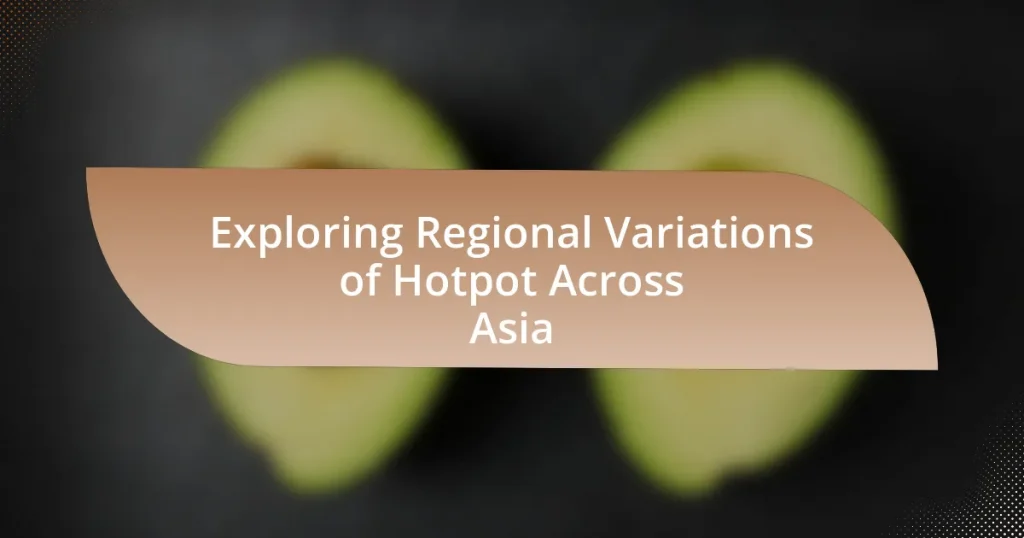The article explores the diverse regional variations of hotpot across Asia, highlighting distinct styles that reflect local ingredients and culinary traditions. It examines how cultural influences shape hotpot styles, detailing common ingredients and cooking methods unique to each region. The historical origins of hotpot are traced back to ancient China, with a discussion on its evolution and cultural significance in various Asian societies. Additionally, the article addresses the social aspects of hotpot dining, including communal experiences and customs, while providing tips for enhancing the hotpot experience and avoiding common preparation mistakes.

What are the regional variations of hotpot across Asia?
Hotpot varies significantly across Asia, with distinct regional styles reflecting local ingredients and culinary traditions. In China, for example, Sichuan hotpot is known for its spicy broth infused with Sichuan peppercorns, while Cantonese hotpot emphasizes a lighter, clear broth with fresh seafood and vegetables. In Japan, shabu-shabu features thinly sliced meat cooked quickly in a pot of boiling water, served with dipping sauces. Korean hotpot, or jeongol, often includes a variety of meats, vegetables, and noodles, cooked together in a rich broth. In Thailand, the hotpot known as sukiyaki combines elements of Chinese and Thai cuisine, featuring a sweet and savory broth. Each of these variations showcases unique flavors and cooking methods, illustrating the diverse culinary landscape of hotpot across Asia.
How do different cultures influence hotpot styles?
Different cultures significantly influence hotpot styles through variations in ingredients, cooking methods, and flavor profiles. For instance, Chinese hotpot often features a spicy broth with a variety of meats and vegetables, reflecting regional preferences such as Sichuan’s bold flavors. In contrast, Japanese shabu-shabu emphasizes thinly sliced beef and a lighter broth, showcasing a focus on freshness and simplicity. Additionally, Korean hotpot, known as jeongol, incorporates a mix of seafood and vegetables, often seasoned with gochujang, highlighting the importance of spice in Korean cuisine. These cultural distinctions illustrate how local tastes and traditions shape the hotpot experience across Asia.
What ingredients are commonly used in various Asian hotpots?
Common ingredients used in various Asian hotpots include thinly sliced meats, seafood, vegetables, and noodles. For example, in Chinese hotpot, ingredients often consist of beef, lamb, fish, shrimp, mushrooms, leafy greens, and tofu. In Japanese shabu-shabu, the focus is on thinly sliced beef, vegetables like napa cabbage, and udon noodles. Korean hotpot, known as jjigae, typically features ingredients such as pork, kimchi, tofu, and various vegetables. These ingredients are essential for creating the diverse flavors and textures that characterize hotpot dishes across different Asian cultures.
How do cooking methods differ among regions?
Cooking methods differ among regions primarily due to variations in available ingredients, cultural practices, and historical influences. For instance, in East Asia, hotpot is commonly prepared using a communal pot of simmering broth, where diners cook their ingredients at the table, reflecting a social dining experience. In contrast, Southeast Asian regions may incorporate more aromatic spices and herbs into their broths, resulting in a distinct flavor profile that emphasizes freshness and complexity. Additionally, Northern Asian countries often utilize thicker broths and heartier ingredients, such as lamb or beef, influenced by colder climates. These regional differences are supported by culinary studies, such as “The Influence of Geography on Culinary Practices” by Smith and Lee, which highlight how local resources shape cooking techniques and preferences.
What are the historical origins of hotpot in Asia?
The historical origins of hotpot in Asia can be traced back to ancient China, specifically during the Han Dynasty (206 BCE – 220 CE). This communal cooking method evolved from the practice of boiling meat in water, which was a practical way to prepare food for large groups. The concept spread throughout Asia, with variations emerging in countries like Japan, Korea, and Mongolia, each adapting the basic idea to local ingredients and culinary traditions. For instance, the Japanese shabu-shabu and Korean jeongol are direct descendants of the original Chinese hotpot, showcasing regional ingredients and flavors while maintaining the core communal dining experience.
How has hotpot evolved over time in different countries?
Hotpot has evolved significantly over time in different countries, adapting to local tastes and cultural practices. In China, hotpot dates back to the Han Dynasty (206 BC – 220 AD) and has diversified into various regional styles, such as Sichuan’s spicy broth and Cantonese’s lighter, herbal options. In Japan, shabu-shabu emerged in the 20th century, focusing on thinly sliced meat and fresh vegetables, reflecting the country’s emphasis on seasonal ingredients. Meanwhile, in Korea, the introduction of jjigae-style hotpot incorporates fermented ingredients like kimchi, showcasing the country’s unique flavor profiles. Each country’s hotpot variation illustrates a blend of historical influences and contemporary culinary trends, demonstrating the dish’s adaptability and enduring popularity across Asia.
What cultural significance does hotpot hold in Asian societies?
Hotpot holds significant cultural importance in Asian societies as it symbolizes communal dining and social bonding. This cooking method encourages shared experiences, where individuals gather around a pot to cook and enjoy food together, fostering relationships and enhancing family ties. In countries like China, hotpot is often associated with celebrations and gatherings, reflecting the value placed on togetherness in social customs. Additionally, the variety of ingredients and regional styles of hotpot, such as Sichuan spicy hotpot or Japanese shabu-shabu, showcase local culinary traditions and preferences, further embedding hotpot into the cultural fabric of these societies.

What are the most popular types of hotpot in Asia?
The most popular types of hotpot in Asia include Sichuan hotpot, Japanese shabu-shabu, Korean jeongol, and Thai suki. Sichuan hotpot is known for its spicy broth and variety of ingredients, often featuring Sichuan peppercorns for a unique flavor. Japanese shabu-shabu emphasizes thinly sliced meat and fresh vegetables, typically cooked in a light broth. Korean jeongol is a hearty stew that combines various ingredients, including meat, seafood, and vegetables, often seasoned with gochujang. Thai suki is characterized by its sweet and spicy dipping sauce, with a mix of meats and vegetables cooked in a flavorful broth. Each type reflects regional tastes and cooking styles, showcasing the diversity of hotpot across Asia.
How does Chinese hotpot differ from Japanese shabu-shabu?
Chinese hotpot primarily differs from Japanese shabu-shabu in its cooking style and ingredient variety. In Chinese hotpot, diners cook a wide range of ingredients, including meats, seafood, and vegetables, in a simmering pot of broth that can be spicy or mild, often accompanied by various dipping sauces. In contrast, Japanese shabu-shabu focuses on thinly sliced beef or pork, which is briefly swished in a light broth, typically flavored with kombu (seaweed), and served with a simple dipping sauce like ponzu. This distinction highlights the broader ingredient selection and flavor profiles in Chinese hotpot compared to the more minimalist approach of shabu-shabu.
What are the key characteristics of Sichuan hotpot?
Sichuan hotpot is characterized by its bold and spicy flavors, primarily derived from Sichuan peppercorns and chili oil. This regional variation features a communal cooking style where diners cook a variety of ingredients, such as meats, vegetables, and tofu, in a simmering pot of spicy broth. The use of numbing spices, particularly the unique combination of Sichuan peppercorns, creates a distinctive tingling sensation on the palate. Additionally, Sichuan hotpot often includes a dual broth option, allowing for both spicy and mild flavors, catering to diverse taste preferences. The emphasis on fresh, high-quality ingredients and the interactive dining experience further define this popular dish in Sichuan cuisine.
How does the broth vary between different types of hotpot?
The broth in hotpot varies significantly based on regional styles, with each type showcasing unique flavors and ingredients. For instance, Sichuan hotpot features a spicy, numbing broth made with Sichuan peppercorns and chili oil, while Cantonese hotpot typically uses a lighter, clear broth flavored with seafood and herbs. In contrast, Japanese shabu-shabu employs a simple kombu (seaweed) broth that enhances the natural flavors of the ingredients. Additionally, Korean hotpot, known as jeongol, often includes a rich, savory broth made from beef or seafood stock, infused with gochujang (Korean chili paste) for added depth. These variations reflect local culinary traditions and ingredient availability, demonstrating how broth is a defining characteristic of each hotpot style.
What unique hotpot styles exist in Southeast Asia?
Unique hotpot styles in Southeast Asia include Thai suki, Vietnamese lẩu, and Malaysian steamboat. Thai suki features a spicy broth with a variety of vegetables, meats, and seafood, often accompanied by a dipping sauce made from chili and lime. Vietnamese lẩu is characterized by its aromatic broth, typically made with herbs and spices, and is served with fresh ingredients like seafood, beef, and vegetables, allowing for a communal dining experience. Malaysian steamboat combines elements from Chinese hotpot, featuring a dual broth option, and offers a wide range of ingredients, including fish balls, tofu, and various meats, reflecting the multicultural influences in Malaysia. These styles showcase the diverse culinary traditions and preferences across Southeast Asia.
How does Thai hotpot (suki) differ from Vietnamese hotpot (lẩu)?
Thai hotpot, known as suki, differs from Vietnamese hotpot, or lẩu, primarily in its flavor profile and ingredients. Sukiyaki typically features a broth seasoned with soy sauce, garlic, and chili, creating a savory and slightly spicy taste, while lẩu often has a more aromatic broth flavored with herbs like lemongrass and galangal, resulting in a fresh and fragrant experience. Additionally, suki commonly includes a variety of meats, seafood, and vegetables, often served with a dipping sauce made from chili and lime, whereas lẩu is characterized by its diverse selection of fresh seafood and meats, often accompanied by rice noodles and a variety of dipping sauces. These distinctions highlight the unique culinary traditions and regional flavors of Thailand and Vietnam.
What regional ingredients are specific to Southeast Asian hotpots?
Southeast Asian hotpots typically feature regional ingredients such as lemongrass, kaffir lime leaves, galangal, and various types of fresh seafood like prawns and fish. These ingredients are integral to the flavor profiles of hotpots in countries like Thailand, Vietnam, and Malaysia, where aromatic herbs and spices enhance the broth. For example, lemongrass and kaffir lime leaves are commonly used in Thai hotpots to impart a citrusy aroma, while galangal adds a unique spiciness. Additionally, fresh seafood is often sourced locally, ensuring that the hotpot reflects the region’s culinary traditions and available resources.

What are the social aspects of enjoying hotpot in Asia?
The social aspects of enjoying hotpot in Asia revolve around communal dining, shared experiences, and cultural traditions. Hotpot is typically enjoyed in groups, fostering interaction and bonding among family and friends as they gather around a shared pot to cook and eat together. This communal aspect enhances social ties and encourages conversation, making it a popular choice for celebrations and gatherings. Additionally, different regions in Asia have unique customs associated with hotpot, such as specific ingredients or dipping sauces, which reflect local culture and preferences, further enriching the social experience. For instance, in China, hotpot is often a centerpiece for family reunions, symbolizing unity and togetherness.
How does hotpot facilitate social interactions among diners?
Hotpot facilitates social interactions among diners by encouraging communal cooking and sharing of food. This dining style requires participants to gather around a shared pot, fostering conversation and collaboration as they cook ingredients together. Research indicates that shared meals enhance social bonding, as evidenced by a study published in the journal “Appetite,” which found that communal dining experiences promote feelings of connection and belonging among participants. The interactive nature of hotpot, where diners select and cook their own ingredients, also stimulates engagement and discussion, making it a unique social experience.
What role does sharing food play in the hotpot experience?
Sharing food is central to the hotpot experience as it fosters communal dining and enhances social interaction among participants. This practice encourages collaboration and connection, as diners cook and share ingredients in a shared pot, creating a sense of togetherness. In many Asian cultures, such as in China and Japan, hotpot meals are designed to be enjoyed with family and friends, emphasizing the importance of community and bonding over food. The act of sharing not only makes the meal more enjoyable but also reflects cultural values of hospitality and unity, reinforcing relationships among diners.
How do dining customs around hotpot vary by region?
Dining customs around hotpot vary significantly by region, reflecting local ingredients, cultural practices, and social interactions. In China, for instance, hotpot is often a communal experience where diners share a pot and cook various ingredients together, emphasizing togetherness and social bonding. In contrast, in Japan, shabu-shabu, a type of hotpot, is typically more individualistic, with diners cooking their own portions in smaller pots, highlighting personal preference and control over cooking. Additionally, in Thailand, the hotpot experience, known as “suki,” incorporates a variety of dipping sauces and is often accompanied by a more vibrant, spicy flavor profile, showcasing the region’s culinary preferences. These regional variations illustrate how hotpot customs are deeply intertwined with local culture and dining etiquette.
What tips can enhance the hotpot dining experience?
To enhance the hotpot dining experience, diners should focus on selecting a variety of fresh ingredients, balancing flavors, and utilizing dipping sauces effectively. Choosing high-quality meats, seafood, and vegetables ensures a richer taste, while incorporating diverse broths can cater to different palates. For instance, a spicy Sichuan broth can complement milder ingredients, creating a harmonious blend of flavors. Additionally, using a range of dipping sauces, such as sesame paste or chili oil, allows for personalized flavor enhancement, making each bite unique. This approach not only elevates the overall meal but also aligns with traditional practices observed in various Asian hotpot cultures, where ingredient selection and sauce variety are key to an enjoyable experience.
How can one choose the best ingredients for a hotpot meal?
To choose the best ingredients for a hotpot meal, prioritize fresh, high-quality items that complement the broth and enhance the overall flavor. Selecting a variety of proteins such as thinly sliced beef, pork, or seafood, along with an assortment of vegetables like mushrooms, leafy greens, and root vegetables, creates a balanced meal. Additionally, incorporating noodles or rice can provide substance. The freshness of ingredients is crucial; for example, using seasonal vegetables ensures optimal taste and nutritional value. According to culinary experts, the combination of textures and flavors from diverse ingredients elevates the hotpot experience, making it more enjoyable and satisfying.
What are some common mistakes to avoid when preparing hotpot?
Common mistakes to avoid when preparing hotpot include using low-quality ingredients, not balancing flavors, and overcrowding the pot. Low-quality ingredients can lead to a subpar dining experience, as fresh and high-quality meats and vegetables are essential for flavor. Failing to balance flavors, such as not incorporating enough broth seasoning or using overly salty sauces, can result in an unappetizing dish. Overcrowding the pot can hinder cooking efficiency, making it difficult for ingredients to cook evenly and affecting the overall texture and taste.










